Microstructure, Mechanical Properties, Deformation Behavior, and Crystallographic Texture of the Al-Gd-Cr-Ti Quaternary Alloy for Thermal Neutron Absorption
Abstract
1. Introduction
2. Materials and Methods
3. Results and Discussion
4. Conclusions
Author Contributions
Funding
Data Availability Statement
Acknowledgments
Conflicts of Interest
References
- Wu, X.; Zhu, Y. Heterogeneous materials: A new class of materials with unprecedented mechanical properties. Mater. Res. Lett. 2017, 5, 527–532. [Google Scholar] [CrossRef]
- Long, S.-L.; Pan, S.-S.; Yang, M.; Luo, X.-L.; Ling, M.; Gui, Q.; Yi, Y.-L. Effects of stirring friction on the microstructure, texture and mechanical properties of 7055 aluminum alloy. J. Mater. Res. Technol. 2024, 33, 5413–5424. [Google Scholar] [CrossRef]
- Amer, S.M.; Barkov, R.Y.; Prosviryakov, A.S.; Pozdniakov, A.V. Structure and Properties of New Wrought Al–Cu–Y- and Al–Cu–Er-Based Alloys. Phys. Met. Metallogr. 2021, 122, 915–922. [Google Scholar] [CrossRef]
- Amer, S.; Barkov, R.; Pozdniakov, A. Microstructure and mechanical properties of novel quasibinary Al-Cu-Yb and Al-Cu-Gd alloys. Metals 2021, 11, 476. [Google Scholar] [CrossRef]
- Yang, H.; Sun, C.; Li, Y.; Cheng, K.; Liu, Y.; Wu, J.; Liu, H.; Wang, J.; Zhao, D.; Song, L.; et al. Effect of grain size and dislocation density on thermal stability of Al-Cu-Mg alloy. Materialia 2024, 38, 102276. [Google Scholar] [CrossRef]
- Kozakevich, J.R.; Sediako, D.; Weiss, D.; Vogel, S.C. A Quantitative Phase Analysis by Neutron Diffraction of Conventional and Advanced Aluminum Alloys Thermally Conditioned for Elevated-Temperature Applications. Materials 2024, 17, 4311. [Google Scholar] [CrossRef]
- Šmalc, J.; Vončina, M.; Mrvar, P.; Balaško, T.; Krutiš, V.; Petrič, M. The Influence of Foundry Scrap Returns on Chemical Composition and Microstructure Development of AlSi9Cu3 Alloy. Crystals 2023, 13, 757. [Google Scholar] [CrossRef]
- Lu, Y.; Wu, C.; Wu, H.; Wang, J.; Su, Y.; Gan, Z.; Liu, J. Growth Mechanism of Eutectic Si in Super-Gravity Solidified Al-Si Alloy during Annealing. Crystals 2023, 13, 684. [Google Scholar] [CrossRef]
- Su, X.; Qu, H.; Lei, Y.; Hou, R.; Cao, Y.; Siddique, S.; Qi, Z.; Shen, G.; Fan, X. Influence of Ni on the Microstructures and Mechanical Properties of Heat-Treated Al-Cu-Ce-Mn-Zr Alloys. Crystals 2023, 13, 380. [Google Scholar] [CrossRef]
- Abdu, A.; Limmaneevichitr, C.; Patakham, U.; Zheng, J.; Zheng, C.; Pandee, P. Microstructural evolution and thermal stability of hypoeutectic Al–Ce alloys with Ni and Fe additions. J. Mater. Res. Technol. 2025, 36, 3465–3474. [Google Scholar] [CrossRef]
- Zhang, H.; Wu, M.; Li, Z.; Xiao, D.; Huang, Y.; Huang, L.; Liu, W. Microstructure and Mechanical Properties of As-Cast Al-10Ce-3Mg-xZn Alloys. Materials 2024, 17, 3999. [Google Scholar] [CrossRef]
- Ye, K.; Cai, X.; Sun, B.; Zhou, L.; Ma, S.; Yue, Y.; Xu, F.; Zheng, D.; Fu, X. Effect of rare earth Ce on the microstructure and mechanical properties of cast Al–7Si alloys. J. Sci. Adv. Mater. Devices 2023, 8, 100634. [Google Scholar] [CrossRef]
- Song, M.; Wu, Z.; He, Y. Effects of Yb on the mechanical properties and microstructures of an Al-Mg alloy. Mater. Sci. Eng. A 2008, 497, 519–523. [Google Scholar] [CrossRef]
- Mamzurina, O.I.; Amer, S.M.; Glavatskikh, M.V.; Barkov, R.Y.; Loginova, I.S.; Pozdniakov, A.V. Microstructure and Mechanical Properties of Novel Heat Resistant Cast Al-Cu-Yb(Gd)-Mg-Mn-Zr Alloys. Metals 2022, 12, 2079. [Google Scholar] [CrossRef]
- Wang, Z.; Pan, J.; Liu, A.; Zhang, L.; Sun, Z.; Wang, Z.; Li, J.; Xiao, X. Microstructure and properties controlling of Al-xGd alloys for thermal neutron absorbing. J. Nucl. Mater. 2025, 603, 155447. [Google Scholar] [CrossRef]
- Okamoto, H. Al-Gd (aluminum-gadolinium). J. Phase Equilibria 2002, 23, 380. [Google Scholar] [CrossRef]
- Zhang, X.G.; Mei, F.Q.; Zhang, H.Y.; Wang, S.H.; Fang, C.F.; Hao, H. Effects of Gd and Y additions on microstructure and properties of Al-Zn-Mg-Cu-Zr alloys. Mater. Sci. Eng. A 2012, 552, 230–235. [Google Scholar] [CrossRef]
- Brokmeier, H.G. Global crystallographic textures obtained by neutron and synchrotron radiation. Phys. B Condens. Matter 2006, 385–386, 623–625. [Google Scholar] [CrossRef]
- Ghosh, P.; Kormout, K.S.; Todt, J.; Lienert, U.; Keckes, J.; Pippan, R. An investigation on shear banding and crystallographic texture of Ag–Cu alloys deformed by high-pressure torsion. Proc. Inst. Mech. Eng. Part C J. Mech. Eng. Sci. 2019, 233, 794–806. [Google Scholar] [CrossRef]
- Lychagina, T.; Zisman, A.; Yashina, E.; Nikolayev, D. Directly verifiable neutron diffraction technique to determine retained austenite in steel. Adv. Eng. Mater. 2018, 20, 1700559. [Google Scholar] [CrossRef]
- Schäfer, W. Neutron diffraction applied to geological texture and stress analysis. Eur. J. Mineral. 2002, 14, 263–289. [Google Scholar] [CrossRef]
- Yousefi Mehr, V.; Toroghinejad, M.R. On the texture evolution of aluminum-based composites manufactured by ARB process: A review. J. Mater. Res. Technol. 2022, 21, 1095–1109. [Google Scholar] [CrossRef]
- Klosek, V. Crystallographic Textures—Measurement. EPJ Web Conf. 2017, 115, 00005. [Google Scholar] [CrossRef]
- Li, S.; Zhao, Q.; Liu, Z.; Li, F. A Review of Texture Evolution Mechanisms During Deformation by Rolling in Aluminum Alloys. J. Mater. Eng. Perform. 2018, 27, 3350–3373. [Google Scholar] [CrossRef]
- Yoshida, K.; Ishizaka, T.; Kuroda, M.; Ikawa, S. The effects of texture on formability of aluminum alloy sheets. Acta Mater. 2007, 55, 4499–4506. [Google Scholar] [CrossRef]
- Sidor, J.J. Effect of hot band on texture evolution and plastic anisotropy in aluminium alloys. Metals 2021, 11, 1310. [Google Scholar] [CrossRef]
- Wang, X.; Shi, T.; Jiang, Z.; Chen, W.; Guo, M.; Zhang, J.; Zhuang, L.; Wang, Y. Relationship among grain size, texture and mechanical properties of aluminums with different particle distributions. Mater. Sci. Eng. A 2019, 753, 122–134. [Google Scholar] [CrossRef]
- Yuan, H.; Wang, Q.F.; Zhang, J.W.; Liu, W.C.; Gao, Y.K. Effect of grain shape on the texture evolution during cold rolling of Al-Mg alloys. J. Alloys Compd. 2011, 509, 922–928. [Google Scholar] [CrossRef]
- Roy, R.K.; Kar, S.; Das, S. Evolution of microstructure and mechanical properties during annealing of cold-rolled AA8011 alloy. J. Alloys Compd. 2009, 468, 122–129. [Google Scholar] [CrossRef]
- Sarkar, J.; Saimoto, S.; Mathew, B.; Gilman, P.S. Microstructure, texture and tensile properties of aluminum-2 at.% neodymium alloy as used in flat panel displays. J. Alloys Compd. 2009, 479, 719–725. [Google Scholar] [CrossRef]
- Deng, Y.L.; Wan, L.; Zhang, Y.; Zhang, X.M. Evolution of microstructures and textures of 7050 Al alloy hot-rolled plate during staged solution heat-treatments. J. Alloys Compd. 2010, 498, 88–94. [Google Scholar] [CrossRef]
- El-Genk, M.S.; Palomino, L.M. A walk-away safe, Very-Small, Long-LIfe, Modular (VSLLIM) reactor for portable and stationary power. Ann. Nucl. Energy 2019, 129, 181–198. [Google Scholar] [CrossRef]
- Ding, Y.; Yang, C.; Zheng, Q.; Liu, Z.; Yang, W. Design, fabrication and mechanical properties of a novel Al-5Cu-6Gd-10Bi alloy potentially used for shielding both thermal neutron and γ-ray. J. Alloys Compd. 2025, 1014, 178670. [Google Scholar] [CrossRef]
- Kučeráková, M.; Rohlíček, J.; Vratislav, S.; Jarošová, M.; Kalvoda, L.; Nikolayev, D.; Lychagina, T.; Douda, K. Texture of the freshwater shells from the unionidae family collected in the czech republic investigated by x-ray and neutron diffraction. Crystals 2021, 11, 1483. [Google Scholar] [CrossRef]
- Kucerakova, M.; Rohlicek, J.; Vratislav, S.; Nikolayev, D.; Lychagina, T.; Kalvoda, L.; Douda, K. Texture Study of Sinanodonta Woodiana Shells by X-Ray Diffraction. J. Surf. Investig. X-Ray Synchrotron Neutron Tech. 2021, 15, 640–643. [Google Scholar] [CrossRef]
- Isaenkova, M.; Perlovich, Y.; Fesenko, V. Regularities of crystallographic texture formation in cladding tubes from Zr-based alloys during their production. IOP Conf. Ser. Mater. Sci. Eng. 2016, 130, 553–561. [Google Scholar] [CrossRef]
- Keppler, R.; Ullemeyer, K.; Behrmann, J.; Stipp, M. Potential of full pattern fit methods for the texture analysis of geological materials: Implications from texture measurements at the recently upgraded neutron time-of-flight diffractometer SKAT. J. Appl. Crystallogr. 2014, 47, 1520–1534. [Google Scholar] [CrossRef]
- Lu, C.; Luo, Z. Critical evaluation of (110) texture in lithium electrodeposits on isotropic Cu polycrystals. Nat. Commun. 2022, 13, 5673. [Google Scholar] [CrossRef]
- Li, J.; Li, F.; Ma, X.; Li, J.; Liang, S.; Zhang, L. Effects of Heat Treatment on Microstructure and Mechanical Properties of an ECAPed Al–Zn–Mg–Cu Alloy. Adv. Eng. Mater. 2018, 20, 1701155. [Google Scholar] [CrossRef]
- Yeni, M.Z.; Prindo, K.P.; Tri, P.; Agus, P. Homogenization Process for Aluminum As-Cast from Waste of Beverage Cans. Mater. Sci. Forum 2022, 1057, 189–194. [Google Scholar] [CrossRef]
- Wang, X.; Guo, M.; Zhang, J.; Zhuang, L. Effect of Zn addition on the microstructure, texture evolution and mechanical properties of Al-Mg-Si-Cu alloys. Mater. Sci. Eng. A 2016, 677, 522–533. [Google Scholar] [CrossRef]
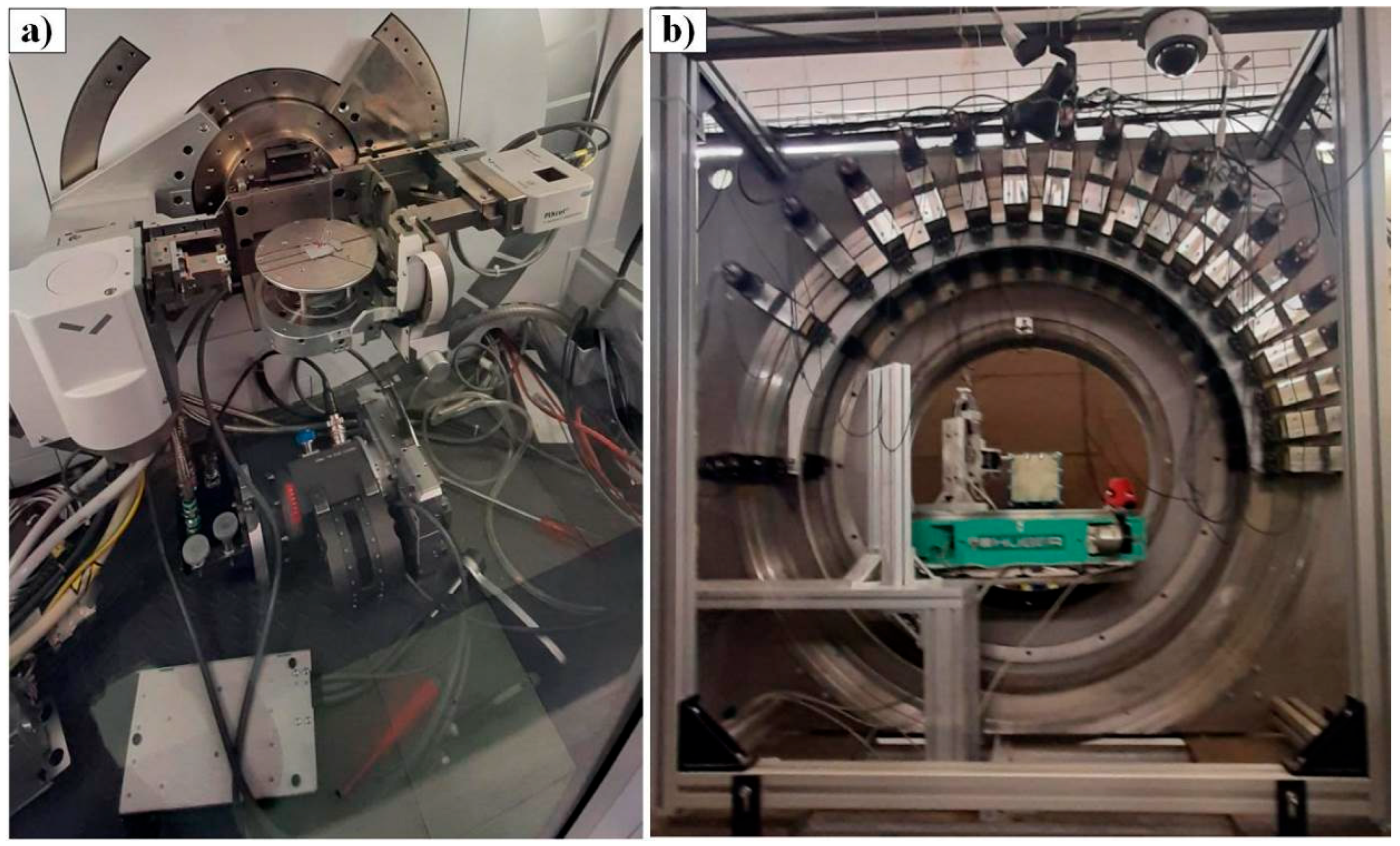

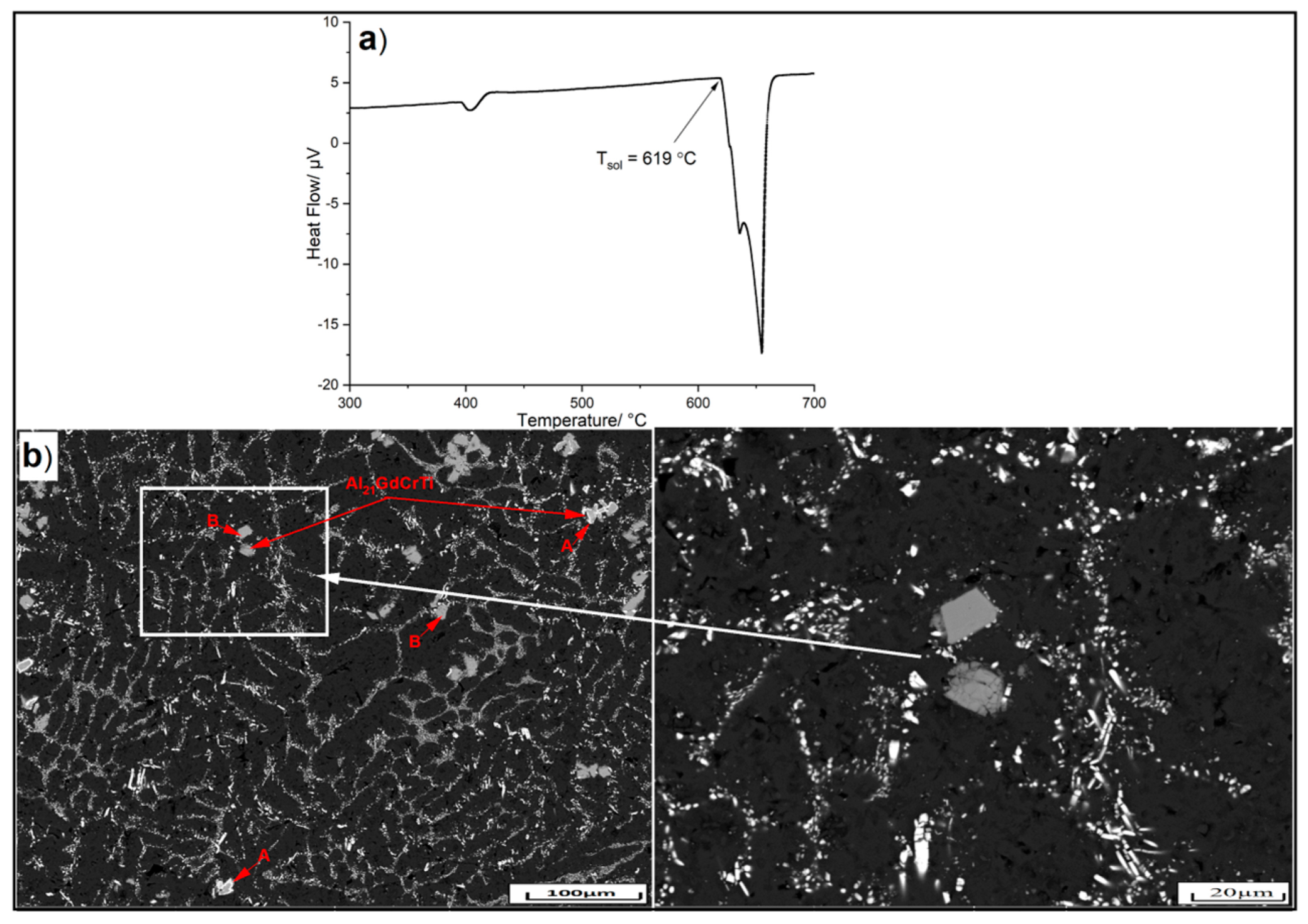
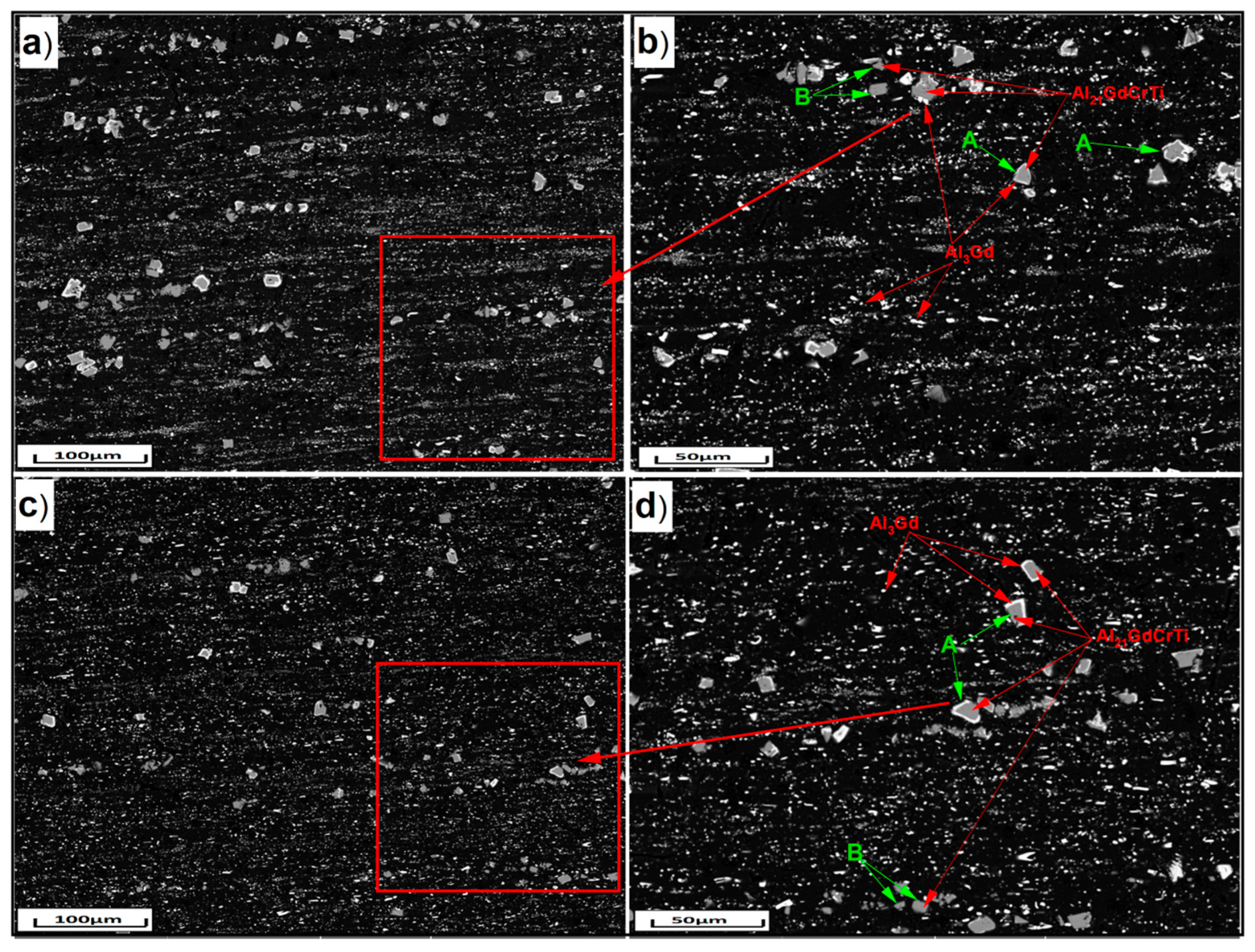
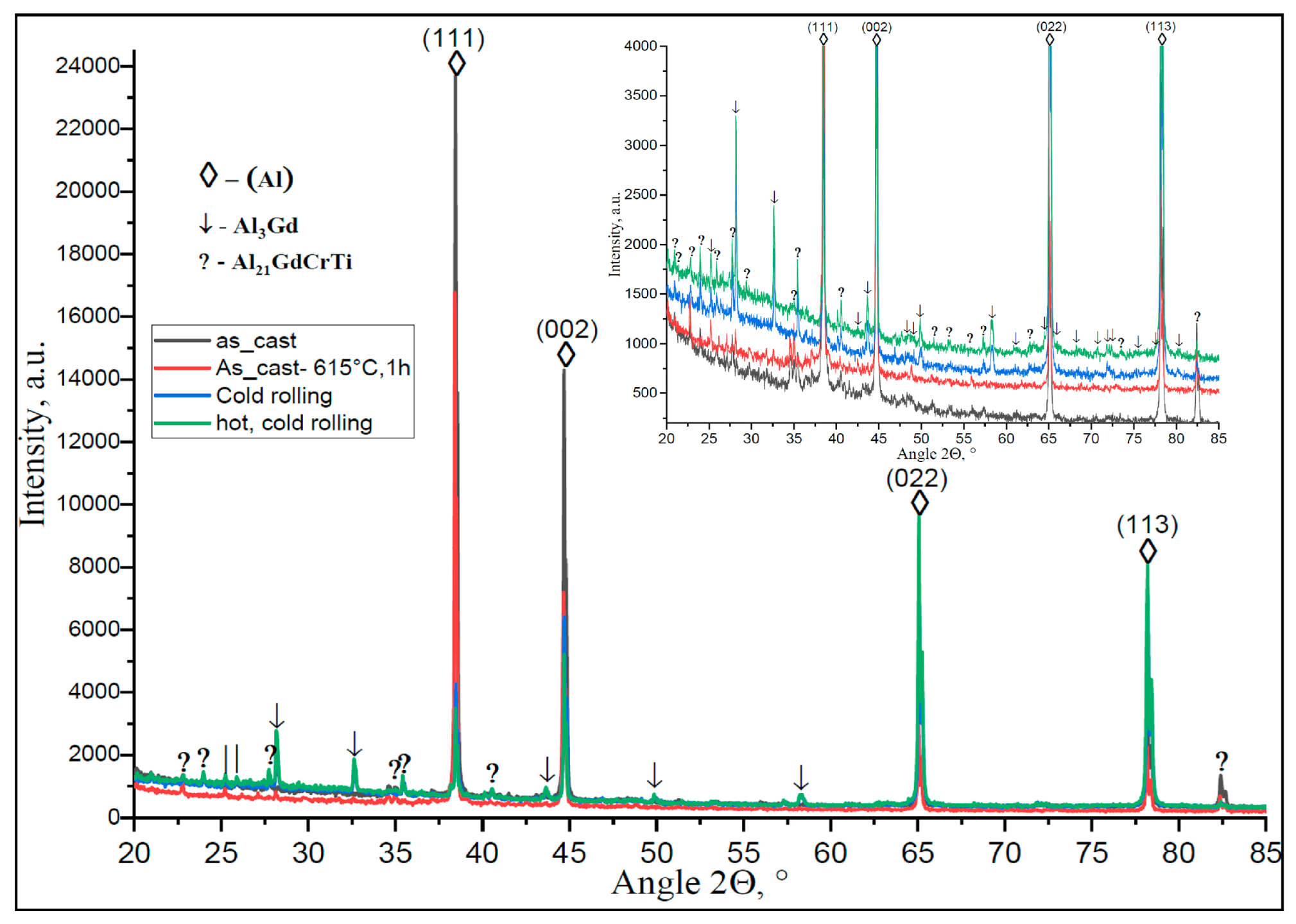

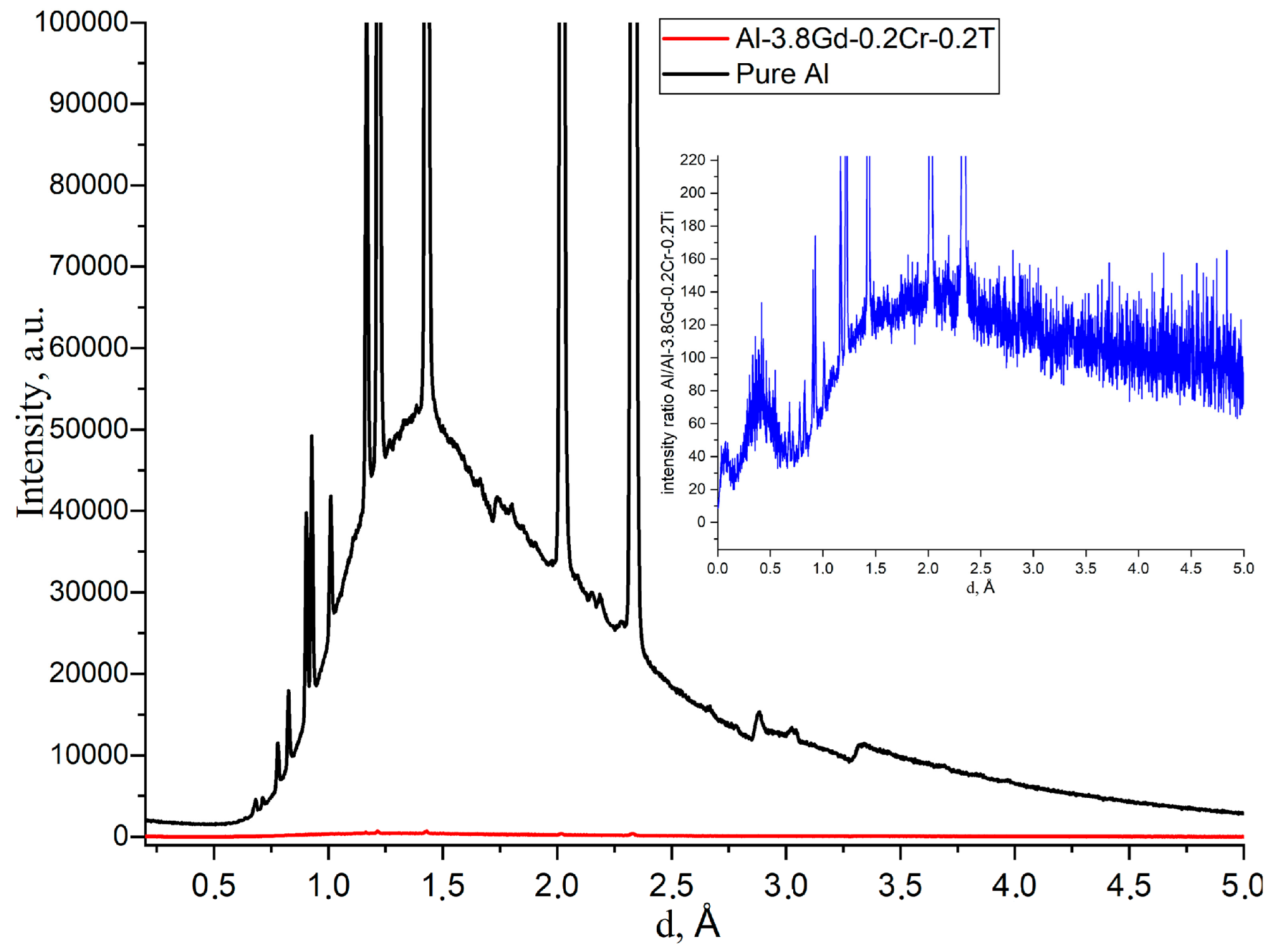
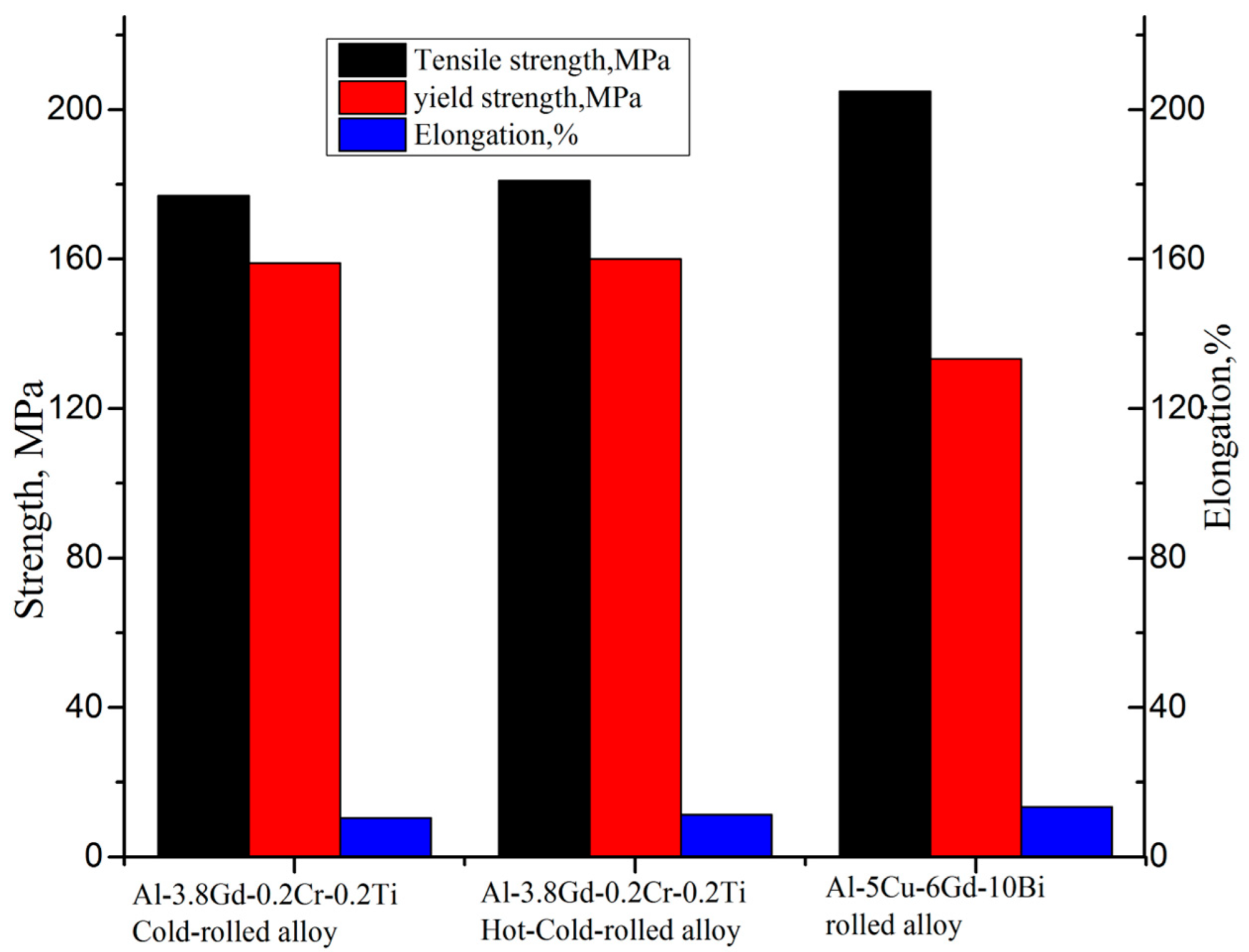
| Alloy | Gd | Cr | Ti | Al |
|---|---|---|---|---|
| Al-Gd-Cr-Ti | 3.8 | 0.2 | 0.2 | bal. |
| Regime | As-Cast | As-Cast with Homogenization at 615 °C for 1 h | As-Cold-Rolled | As-Hot-Cold-Rolled | |||||||||||||
|---|---|---|---|---|---|---|---|---|---|---|---|---|---|---|---|---|---|
| Intensity | (111) | (002) | (022) | (113) | (111) | (002) | (022) | (113) | (111) | (002) | (022) | (113) | (111) | (002) | (022) | (113) | |
| Min | 0.131 | 0.438 | 0.381 | 0.677 | 0.116 | 0.338 | 0.462 | 0.606 | 0.255 | 0.403 | 0.392 | 0.627 | 0.364 | 0.506 | 0.462 | 0.670 | |
| Max | 2.074 | 3.248 | 1.405 | 1.705 | 3.184 | 5.941 | 2.578 | 2.244 | 2.139 | 2.139 | 2.126 | 2.664 | 2.828 | 2.126 | 2.664 | 2.353 | |
Disclaimer/Publisher’s Note: The statements, opinions and data contained in all publications are solely those of the individual author(s) and contributor(s) and not of MDPI and/or the editor(s). MDPI and/or the editor(s) disclaim responsibility for any injury to people or property resulting from any ideas, methods, instructions or products referred to in the content. |
© 2025 by the authors. Licensee MDPI, Basel, Switzerland. This article is an open access article distributed under the terms and conditions of the Creative Commons Attribution (CC BY) license (https://creativecommons.org/licenses/by/4.0/).
Share and Cite
Amer, S.M.; Nikolayev, D.I.; Lychagina, T.A.; El-Khouly, A.; Barkov, R.Y.; Prosviryakov, A.S.; Mikhaylovskaya, A.V.; Glavatskikh, M.V.; Pozdniakov, A.V. Microstructure, Mechanical Properties, Deformation Behavior, and Crystallographic Texture of the Al-Gd-Cr-Ti Quaternary Alloy for Thermal Neutron Absorption. Crystals 2025, 15, 616. https://doi.org/10.3390/cryst15070616
Amer SM, Nikolayev DI, Lychagina TA, El-Khouly A, Barkov RY, Prosviryakov AS, Mikhaylovskaya AV, Glavatskikh MV, Pozdniakov AV. Microstructure, Mechanical Properties, Deformation Behavior, and Crystallographic Texture of the Al-Gd-Cr-Ti Quaternary Alloy for Thermal Neutron Absorption. Crystals. 2025; 15(7):616. https://doi.org/10.3390/cryst15070616
Chicago/Turabian StyleAmer, Sayed M., Dmitry I. Nikolayev, Tatiana A. Lychagina, Abdelmoneim El-Khouly, Ruslan Yu. Barkov, Alexey S. Prosviryakov, Anastasia V. Mikhaylovskaya, Maria V. Glavatskikh, and Andrey V. Pozdniakov. 2025. "Microstructure, Mechanical Properties, Deformation Behavior, and Crystallographic Texture of the Al-Gd-Cr-Ti Quaternary Alloy for Thermal Neutron Absorption" Crystals 15, no. 7: 616. https://doi.org/10.3390/cryst15070616
APA StyleAmer, S. M., Nikolayev, D. I., Lychagina, T. A., El-Khouly, A., Barkov, R. Y., Prosviryakov, A. S., Mikhaylovskaya, A. V., Glavatskikh, M. V., & Pozdniakov, A. V. (2025). Microstructure, Mechanical Properties, Deformation Behavior, and Crystallographic Texture of the Al-Gd-Cr-Ti Quaternary Alloy for Thermal Neutron Absorption. Crystals, 15(7), 616. https://doi.org/10.3390/cryst15070616









